
Constables would hide in bushs with stopwatches and ascertain that the appoaching vehicle was exceeding the speed limit of the time. Which was relatively slow.
Many of the major clock and watch makers of the time responded with what became known as "speedometers".
They were varied in the principle they operated on and I'll cover this in a later post.
This post is about the "Bonniksen Isochronous Speedometer".
Invented by a watchmaker called Bahne Bonniksen who immigrated to Coventry from Scandenavia, it came into the hands of Rotherhams & Sons Ltd, of Coventry, an old established firm of watchmakers and engineers, which were established in 1750. They were still in operation in 1989 when I wrote to them enquiring after drawings of the Bonniksen speedometer, see their posted reply to my enquiry.

I believe they ceased trading around 2000.

Initially Rotherham made speedo heads for a royalty to B.Bonnikson from around 1919.
Early reference in "The Motorcycle" 26 Sept.1912 refer to a 50mph isochronous speedometer with the two hands and B.Bonniksen, Coventry on the dial face. There were further references in "The MotorCycle" in 1913 on improvements to the speedometer and then in the 23 November 1919 edition that Rotherham & Sons had taken over manufacture in quantity.
However there was an advertisement in "MotorCycling" 26 May 1920 from B.Bonniksen, Norfolk St., Coventry offering speedo heads for sale, stating they were recommended by Triumph and Rudge and that agents were wanted from abroad.
Supposedly Bonnikson had two patents, No.2052 of 13 June 1912 and another No. 193281 of 22 Feb.1923, however I've searched the European Patents Office website and cannot find any trace of them.
Interestingly there appears to have been, well what I surmise..."some unhappiness" with the arrangement, for Bonniksen's son started to advertise in the Motorcycle weeklies in the 1920's offering the speedometers for sale and repair.

How did the instrument work?
Looking at the photos you will notice there are two hands. On starting, one was at the rest position, zero, the other at the last speed indicated.
This is because the instrument, working on a version of the chronometric principle is an integrating mechanism and actually takes reading of the speed ( well the number of turns of the drive cable) , then displaying it in a time cycle.
This time cycle was initially 5 seconds, then reduced to 2.5 seconds.
So one hand is at zero or rest is awaiting for the new speed to display and the other hand is displaying the speed that occured,
They were mainly made in dial scales of 50mph and 100mph, but were listed as being available in Kilometers, but I've never seen one.
The rest or zero position was the 50 or the 100 scale marking.
They had smaller dial scales within the speed scale and these were the trip miles travelled from 0-10o miles, there being a main odometer that indicated up to 9999.9 miles.
The other scale was the time travelled in hours and minutes.
Interestingly the scale while nominally 50 or 100 miles could continue around to 60,70mph etc in the case of the 50mph scale and 110,120mph in the case of the 100mph scale.
As well a speedometer that only had a main odometer was offered at a reduced cost.
Bonnikson also made the drive gearboxes for the speedometer, mounted on the front fork blade , with a pinion gear engaging with a ring gear attached to the spokes of the front wheel.
The ratio of the gearboxes were either 3-1 or 4.5-1. All the gearboxes and the speedometer cases were nickel plated.
The external drive gears were plated in electrolysis nickel.
For those interested in fitting a Bonniksen...the head ratio is 500 turns per mile.
So using a Bonniksen speedo drive of 3-1 or 4.5-1 or a Smiths FW speedo drive of 1.5-1 you can work out the ring gear and pinion gear sizes you require, knowing that a 3.00x 21 tyre or similar turns approx. 750 times per mile. ( C=π.D...84.84 = 3.412x 27. Then 63360/84.84= 746.)
The ring gear/pinion gear combination has to reduce the 746 wheel turns per mile to the 500 cable turns per mile, taking into account the drive box ratio mentioned.
Speedometers were available as an extra to be purchased, together with the drive parts and fitted after purchase of your motorcycle and it wasn't until the early 1930s that motorcycle manufacturers offered speedometers as "standard equipment".
Brough Superiors were often fitted with Bonniksen speedos with the 100mph version being introduced in May 1925 on a BS.
Today they are expensive to purchase secondhand...how much.... US$1000 wouldn't surprise me with another US$300 plus for the gearbox.
They are quite time consuming to overhaul, obviously no parts being available, so costly to have restored.
Left click on images to enlarge....
Collection of several Bonniksen speedometer drives in pieces. There were two main types, of ratios 3-1 and 4.5-1. The large nut in the centre of the illustration is NOT from a Bonnikson drive...shouldn't be in the pic.













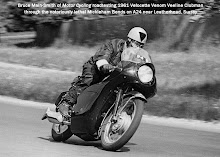

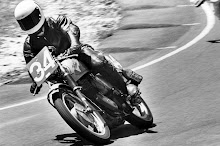

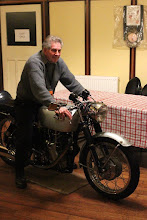
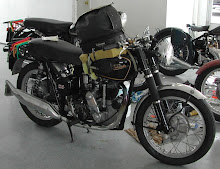
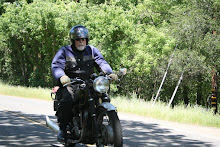


1 comment:
I have a 100mph Bonniksen which I kept from a Brough project - the speedo was too good to sell along! I know, I'm terrible, but I still have it, and am waiting for the right bike to go underneath...
Post a Comment